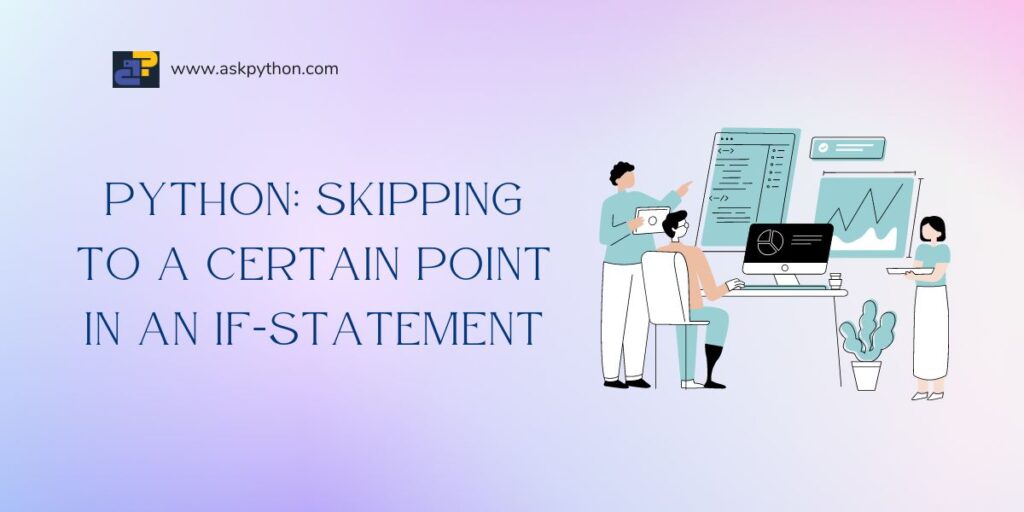Python is a versatile coding language known for its simplicity and readability. While working with Python, you may often need to provide conditions using if-else syntax. Here, we will explore skipping a certain point in an if statement.
You can skip a point in an if statement using the continue statement, nested if statements, or function calls. The continue statement is commonly used in loops but can also be implemented in if-else statements to proceed to the next iteration. Nested if statements allow you to add if-else blocks within the parent block, while function calls encapsulate certain code blocks and skip them when needed.
Also Read: Python String contains: Check if String Contains Substring
Python if/else Statement: What It Is and How to Use It
Think of a scenario where a person has to select a certain option and do things respectively. If-else is a similar concept used to implement conditional situations in real-time. First, we look at the syntax as follows:
if check condition:
# if condition true
else:
# if condition is false
The syntax here shows that if the statement to be checked is true, execute the “if” block. Otherwise, if the statement is false, execute the “else” block. Let’s consider a small example to understand the syntax.
Pseudo Code:
number = 3
if number==3:
print ("Number is 3")
else:
print ("Number is 5")

Here, the user gives an input value to the variable “number”. The if-else statement is used to check if the number is 3. If the number is 3, it prints 3. Otherwise, if the number is not 3, it prints 5.
Also Read: Python if else elif Statement
3 Ways to Skip a Point in Python If Statement
Now imagine you want to skip a certain line of code on a particular check. For this, we can implement different concepts as follows:
Using continue Statement to Skip if Statement in Python
The ‘continue’ statement in Python skips the code inside a loop for a particular iteration or proceeds to the next statement. While ‘continue’ is commonly used in loops, we can implement it in the if-else statements.
Let us consider a situation where we run a ‘for’ loop from 1 to 11. If the number is odd, it will print the number. Else it will skip the number using the ‘continue’ statement
for i in range(1, 11):
if i % 2 == 0:
continue
print(i)

Thus, from the output, we can analyze that Python checks for each number ‘i’ in the range (1,11). If the number is odd, it prints the numbers. Otherwise, it skips that number if it is even.
Nested if Statements: Another Way to Skip if Statement
Another approach that you can use to skip a point in if-statement is Nested if-statements. Nested if –statements refer to adding if-else blocks within the parent if-else block. Let us consider an example:
x = 5
y = 15
if x > 3:
if y > 11:
print("Both conditions met")
else:
print("2nd condition not met")
else:
print("1st condition not met")
Here we have taken two variables ‘x’ and ‘y’. Firstly we will check if the value of x is greater than 3. If the condition is true, it will go inside the second if-else block. Next, it will check if the value of ‘y’ is greater than 11. If the condition is true it will print that “Both conditions met”, else it prints “2nd condition not met”. Lastly, if the first condition is not met it will print “1st condition not met”.

As ‘x’ and ‘y’ have values greater than 3 and 11 respectively, you can see the output as “Both conditions met”.
Function Calls: Encapsulating Code Blocks to Skip if Statement
We can also use function calls to encapsulate certain blocks’ code and skip those parts when needed. Let us understand this via example:
def condition_met():
print("Condition met")
def condition_not_met():
print("Condition not met")
x = 17
if x > 13:
condition_met()
else:
condition_not_met()

In this example, you can see that if the value of x is greater than 5, a particular function is called. This way, we can implement certain code using the function and if-else statements and skip certain codes when needed.
What is the best way to skip the if-statements in Python?
The best way to skip the if-statement in Python is using the ‘continue’ statement. It is used mostly in loops but can be implemented together to address certain conditions.
What are the three ways to skip the if-statements in Python?
In Python, there are three ways to skip the if Statement: using the ‘continue’ statement, using nested if-else, or making separate function calls to implement conditional checks.
Conclusion
Thus, we can say that skipping to a certain point within an if-statement in Python can be achieved using different methods. The concepts such as the ‘continue’ statement, nested if-statements, and function calls are easy to implement and can customize code according to different conditions. Thus, we can write more efficient and readable code using these methods.
